Before you Begin
This tutorial shows you how to create a filter exclusion list, bind the filter to a parameter, and create an exclude parameter that you can use to pass values to another canvas.
Background
In Oracle Analytics, after you create the exclude parameter, you can bind it to other filters in the workbook to pass excluded data values between filters.
The exclude parameter uses an Integer data type that contains Boolean values. Oracle Analytics appends the filtered column's name to the parameter name. For example in this tutorial, you create an exclusion list filter using the Customer Segment column creating Excludes Mode Customer Segment as the parameter name.
What Do You Need?
- Access to Oracle Analytics
- Download sample_order_lines2023.xlsx to your computer
Create a Dataset
In this section, you add the sample_order_lines2023.xlsx file to Oracle Analytics to create a dataset.
- Sign in to Oracle Analytics.
- On the Home page, click Create, and then click Dataset.
- In Create Dataset, click Drop data file here or click to browse, select the sample_order_lines2023.xlsx file, and then click Open.
- In Create Dataset Table from sample_order_lines2023.xlsx, click OK. Click Save
 .
. - In Save Dataset As, enter
sample_order_lines2023, and then click OK.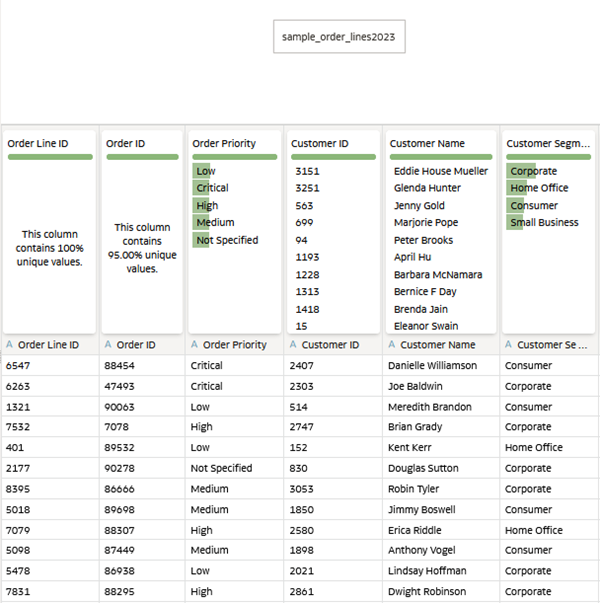
Description of the illustration sample_order_lines_ds.png
Create a Workbook
In this section, you create a workbook, create a calculation to use as a data element, and add a simple table visualization.
- Click Create Workbook. In the workbook, click Close
 to close the Auto Insights panel.
to close the Auto Insights panel. - Right-click My Calculations and click Create Calculation.
- In New Calculation, enter
Number of Customersin Name. In the expression field, enterCouand click the Count expression. - Click column between the expression parentheses, select Customer ID, click Validate, and then click Save.
- In the Data
 pane, hold down the Ctrl key, select Customer Segment and Number of Customers.
pane, hold down the Ctrl key, select Customer Segment and Number of Customers. - Right-click, select Pick Visualization and then click Table
 .
. The Number of Customers calculation uses Customer ID rather than Customer Name to ensure that the count uses only unique instances of customer. In production datasets, multiple customers could have the same first and last name.

Description of the illustration custseg_num_customers_canvas1.png
Add a Dashboard Filter Control
In this section, you add a dashboard control and bind a filter to a parameter.
- Click Visualizations
 . Scroll to the Dashboard Controls section and drag Dashboard Filters to the canvas above the Customer Segment, Number of Customers visualization.
. Scroll to the Dashboard Controls section and drag Dashboard Filters to the canvas above the Customer Segment, Number of Customers visualization.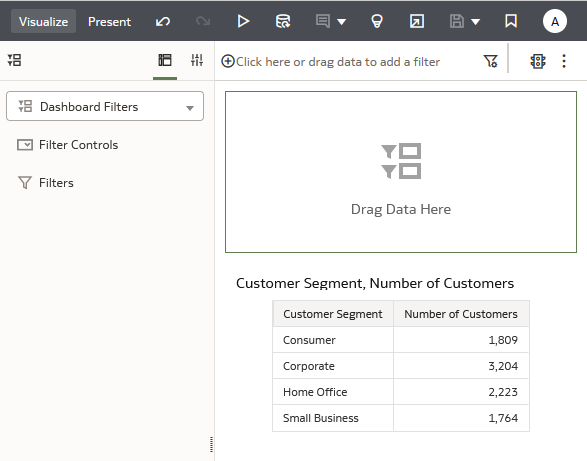
Description of the illustration dashboard_filter_control.png - Click the Data
 .
. - In the Data pane, select Customer Segment and drag it to the Dashboard Filter control.
- Click All in the Customer Segment filter. In the Filter dialog, select Consumer and Corporate. Click Bind to Parameter
 and select Create Parameter.
and select Create Parameter. 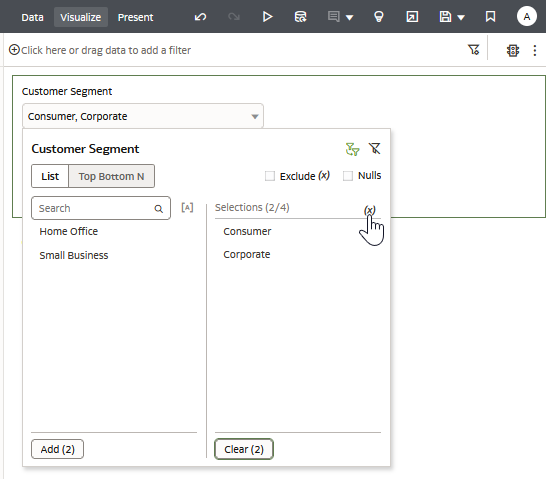
Description of the illustration cust_seg_parameter.png - Click the Parameters
 pane.
pane.
Oracle Analytics adds the parameter created in the Filter dialog to the Parameters pane.
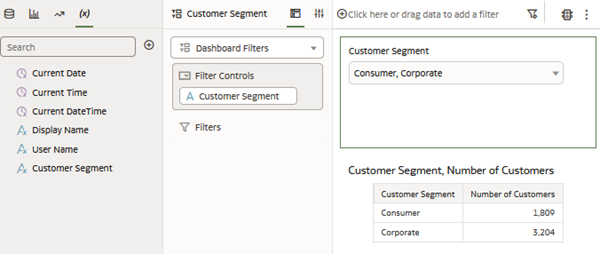
Description of the illustration cust_seg_param.png - Click Save
 . In Save Workbook, enter a Name and then click Save.
. In Save Workbook, enter a Name and then click Save.
Create an Exclusion List Filter and Parameter
In this section, you create a second workbook canvas to act as the target for passing the exclusion list values and create an exclusion list parameter.
- Click Canvas 1 menu
 and select Duplicate Canvas.
and select Duplicate Canvas. - Click Canvas 1 Copy menu
 , select Rename, enter
, select Rename, enter Canvas 2, and click the check . Click Save
. Click Save  .
. - Click Canvas 1.
- In the Dashboard Filter control, click the Customer Segment list to open the Filter dialog.
- Click Exclude to create an exclusion list of the Customer Segment selections. Click Bind to Parameter
 next to Exclude and select Create Parameter.
next to Exclude and select Create Parameter.Oracle Analytics updates the table visualization to use Home Office and Small Business and excludes the number of customers in the Consumer and Corporate customer segment.
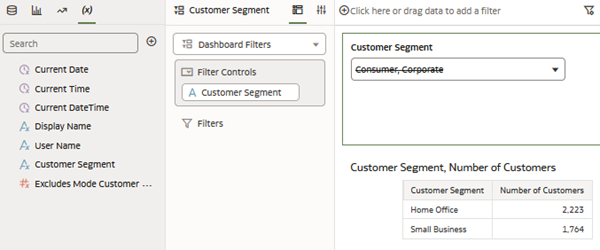
Description of the illustration exclude_param.png - Click Canvas 2. Click the Customer Segment list in the Dashboard Filter control. Click Exclude, click Bind to Parameter
 , and then select Excludes Mode Customer Segment. Click outside the dialog.
, and then select Excludes Mode Customer Segment. Click outside the dialog.Oracle Analytics passes the exclusion list to Canvas 2 and updates the table visualization to use the Home Office and Small Business.
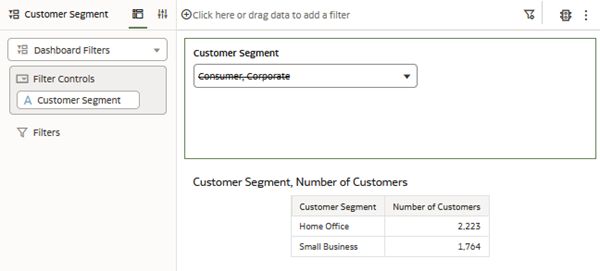
Description of the illustration canvas_2_exclude.png - Click Save
 .
. - Click Preview
 . Select Home Office from the Customer Segment filter to see how the table visualization is updated. Click Canvas 2 to see the value changes from the first canvas.
. Select Home Office from the Customer Segment filter to see how the table visualization is updated. Click Canvas 2 to see the value changes from the first canvas.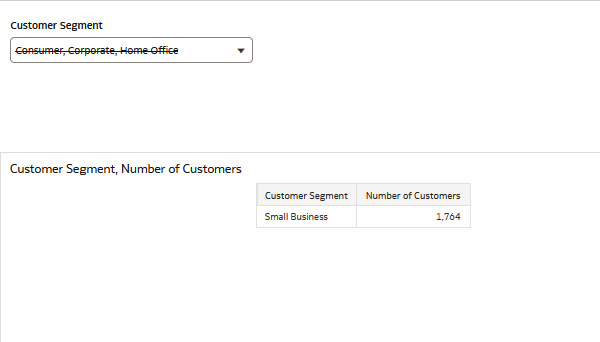
Description of the illustration exclude_preview.png
Learn More
Create and Bind a Parameter to Exclude Filter Values in Oracle Analytics
F99770-01
July 2024
Copyright © 2024, Oracle and/or its affiliates.
Learn how to create a parameter to pass an exclusion list values in Oracle Analytics.
This software and related documentation are provided under a license agreement containing restrictions on use and disclosure and are protected by intellectual property laws. Except as expressly permitted in your license agreement or allowed by law, you may not use, copy, reproduce, translate, broadcast, modify, license, transmit, distribute, exhibit, perform, publish, or display any part, in any form, or by any means. Reverse engineering, disassembly, or decompilation of this software, unless required by law for interoperability, is prohibited.
If this is software or related documentation that is delivered to the U.S. Government or anyone licensing it on behalf of the U.S. Government, then the following notice is applicable:
U.S. GOVERNMENT END USERS: Oracle programs (including any operating system, integrated software, any programs embedded, installed or activated on delivered hardware, and modifications of such programs) and Oracle computer documentation or other Oracle data delivered to or accessed by U.S. Government end users are "commercial computer software" or "commercial computer software documentation" pursuant to the applicable Federal Acquisition Regulation and agency-specific supplemental regulations. As such, the use, reproduction, duplication, release, display, disclosure, modification, preparation of derivative works, and/or adaptation of i) Oracle programs (including any operating system, integrated software, any programs embedded, installed or activated on delivered hardware, and modifications of such programs), ii) Oracle computer documentation and/or iii) other Oracle data, is subject to the rights and limitations specified in the license contained in the applicable contract. The terms governing the U.S. Government's use of Oracle cloud services are defined by the applicable contract for such services. No other rights are granted to the U.S. Government.
This software or hardware is developed for general use in a variety of information management applications. It is not developed or intended for use in any inherently dangerous applications, including applications that may create a risk of personal injury. If you use this software or hardware in dangerous applications, then you shall be responsible to take all appropriate fail-safe, backup, redundancy, and other measures to ensure its safe use. Oracle Corporation and its affiliates disclaim any liability for any damages caused by use of this software or hardware in dangerous applications.
Oracle and Java are registered trademarks of Oracle and/or its affiliates. Other names may be trademarks of their respective owners.
Intel and Intel Inside are trademarks or registered trademarks of Intel Corporation. All SPARC trademarks are used under license and are trademarks or registered trademarks of SPARC International, Inc. AMD, Epyc, and the AMD logo are trademarks or registered trademarks of Advanced Micro Devices. UNIX is a registered trademark of The Open Group.
This software or hardware and documentation may provide access to or information about content, products, and services from third parties. Oracle Corporation and its affiliates are not responsible for and expressly disclaim all warranties of any kind with respect to third-party content, products, and services unless otherwise set forth in an applicable agreement between you and Oracle. Oracle Corporation and its affiliates will not be responsible for any loss, costs, or damages incurred due to your access to or use of third-party content, products, or services, except as set forth in an applicable agreement between you and Oracle.